mobile.de (Adevinta) - EV Experience
mobile.de (Adevinta)
designing the electric vehicle experience for germany’s largest marketplace
The challenge
Germany’s largest vehicle marketplace, mobile.de, had no dedicated electric vehicle (EV) search experience. With growing demand for EVs, this was a major gap. A best-in-class EV search and discovery experience was needed.
The outcome
A successful new EV search experience used by hundreds of thousands of people every month across Web, iOS and Android. Driving:
+38% increase in EV searches
+21% more EVs viewed
+14% increase in messages to dealers (Key business metric)
+6% increase in EV lead ratio
My role
As the sole designer, I led the design strategy, user research, and UX execution from end to end—turning a non-existent EV search experience into a successful and seamless one.
My role covered:
User research & discovery (interviews, competitor analysis, quantitative insights)
Experience design & prototyping (from wireframes to high-fidelity designs)
Stakeholder collaboration & testing (A/B tests, iterations, and launches)
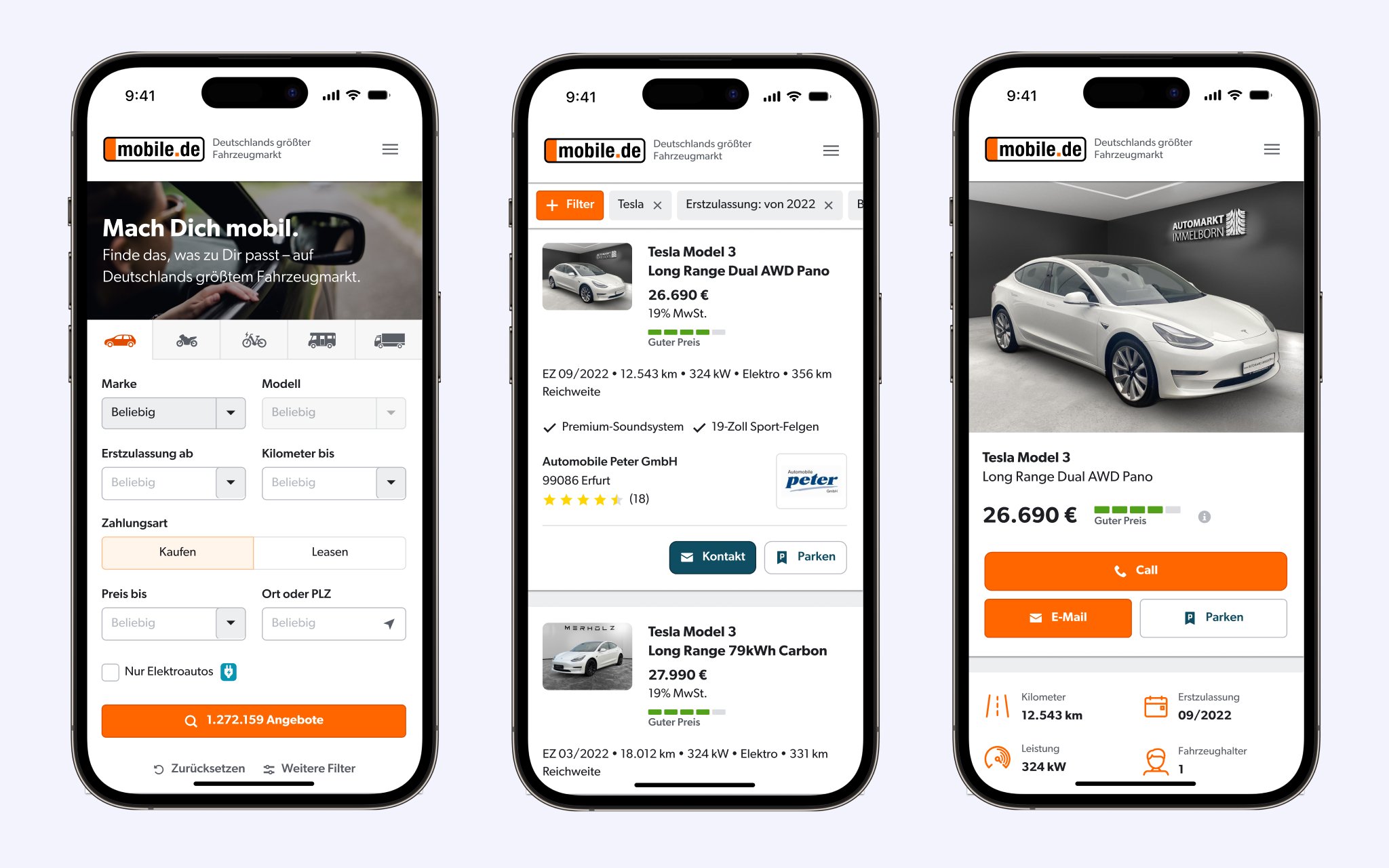
The context
In mid-2022, mobile.de (AutoTrader being the UK equivalent), faced a growing problem: as electric vehicles surged in popularity, their platform was falling behind. EV buyers struggled to find the right cars, dealers lacked visibility, and the search experience for EVs was non-existent.
With Germany's EV adoption accelerating, mobile.de had to act fast—or risk losing users to more EV-friendly competitors.
I was tasked to solve this problem alongside a Product Manager and two full-stack Developers.
Discovery
The PM and I started in late 2022, two months before the Developers joined the company.
This gave us the opportunity to conduct a thorough discovery phase to better understand the EV landscape, problems to solve and opportunity areas.
The Discovery consisted of four main activities:
User interviews
Studies and reports
Testing the current experience and competitor experiences
Expert interviews
User interviews
We recruited three groups of participants, split by their acceptance towards EVs and journey stage:
Recent EV buyers
Those open to buying an EV, but are hesitant
Those who want an EV as their next vehicle
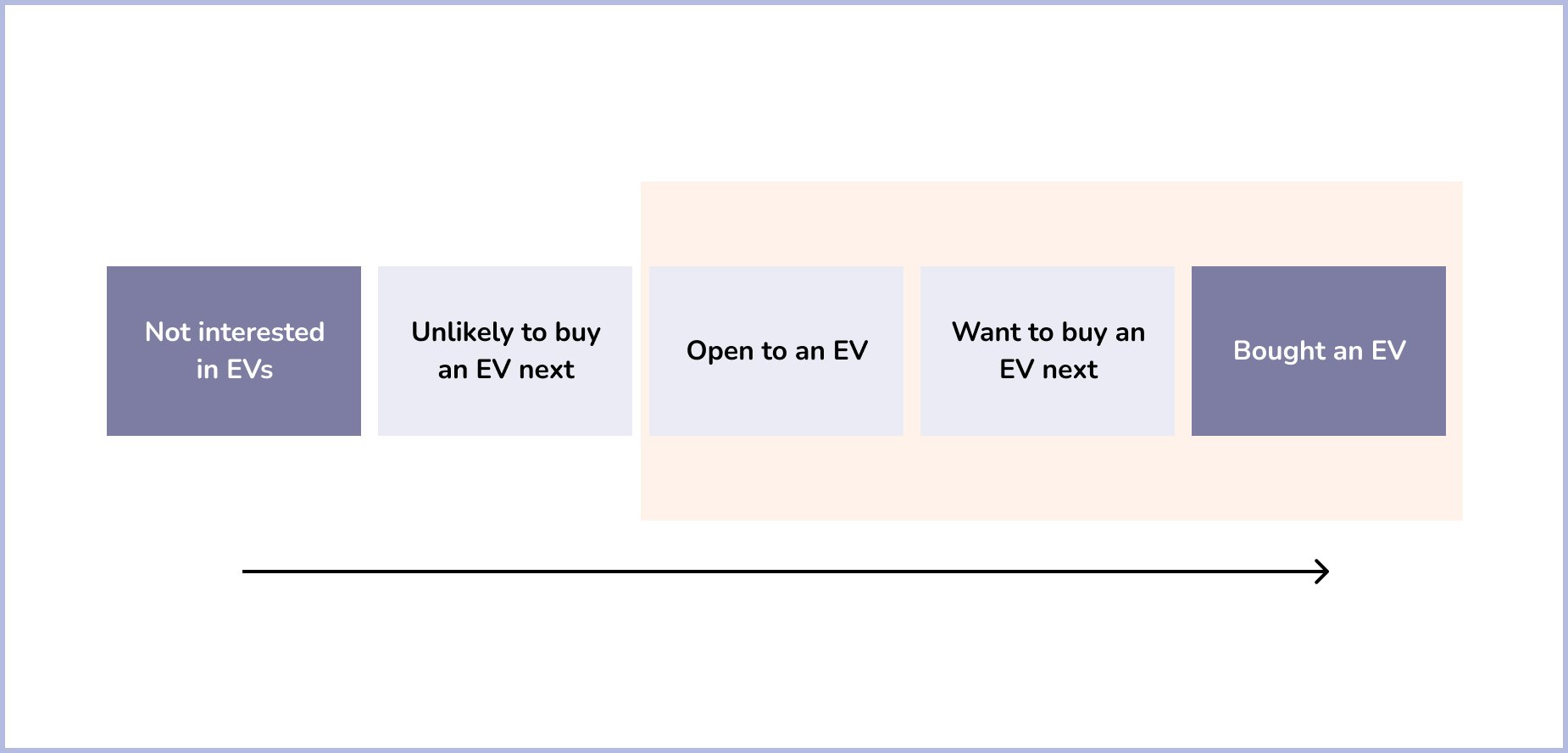
EV consideration phase. Initial focus was on those open and wanting to buy an EV
Recent EV buyers
We heard from recent EV buyers the struggles and pains they had to overcome to feel confident they were making the right purchase.
Open to buying an EV
We heard from people open to an EV, alongside petrol and diesel vehicles. EVs were in their consideration for a new car, but they needed reassurance on certain aspects.
Want an EV
We heard from people ready to buy an EV that the digital tools they were using to find EVs were lacking.
Studies and reports
To compliment our qualitative user interviews, we read reports from quantitative studies from market research companies who had surveyed thousands of people within Germany, about a number of EV topics.
This information and data gave us further confidence around the insights we had gleaned from our own user research, and helped us prioritise the problems to target.
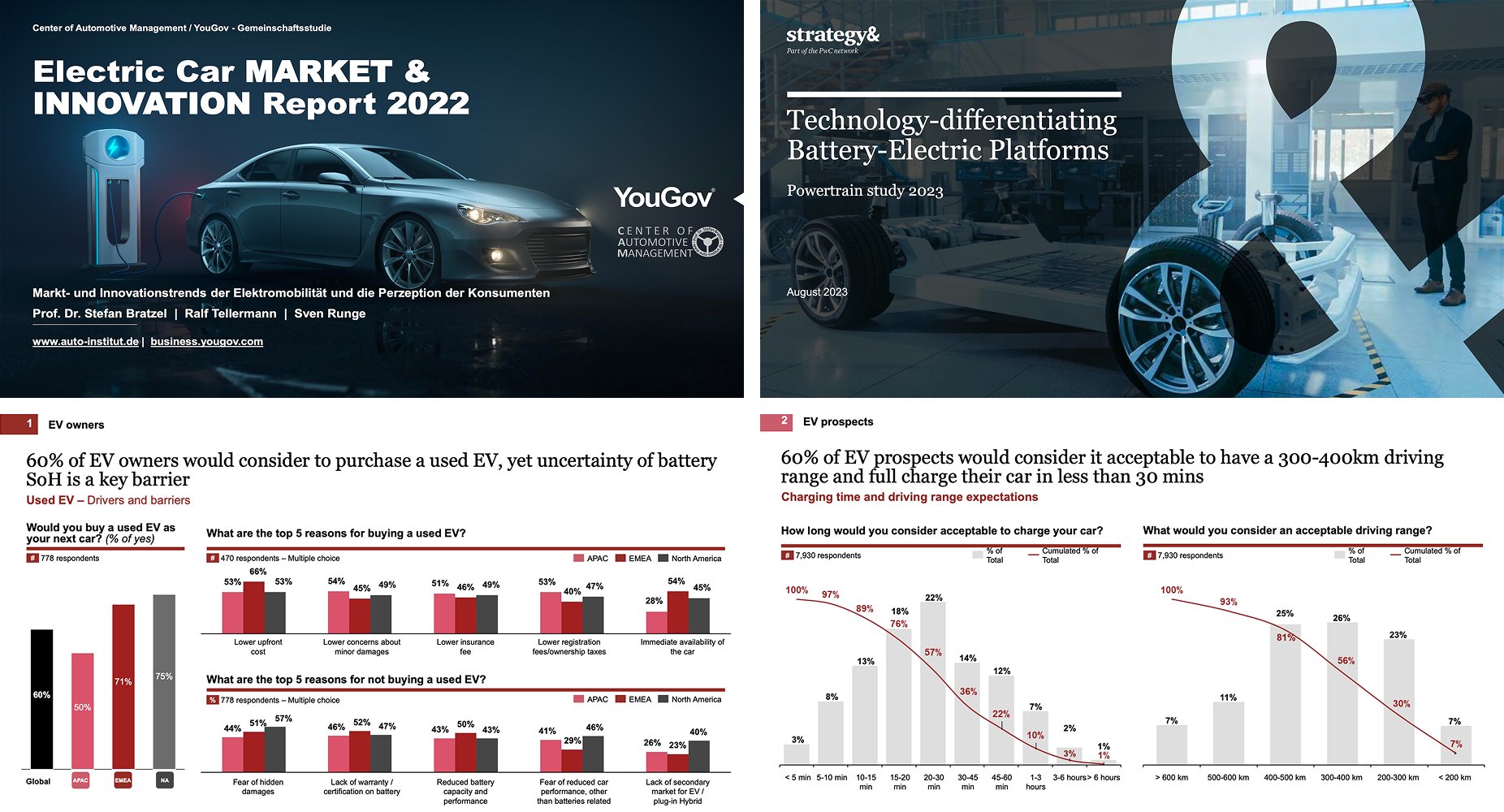
External quantitative studies to compliment our own user research
Testing the current and competitor experiences
As part of the user interviews we observed participants using the live mobile.de EV search experience. Asking them to search for the EV(s) they want and watching where they encountered difficulties.
This was enlightening. Very quickly we saw the scale of the task ahead of us. Apart from a single electric fuel type filter, participants had nothing to work with.
In addition to testing the current mobile.de EV experience, we asked them to use competitor products and equivalents from the US and UK. This proved a useful exercise, we saw quickly the surprise and delight that some of the EV experiences brought participants.
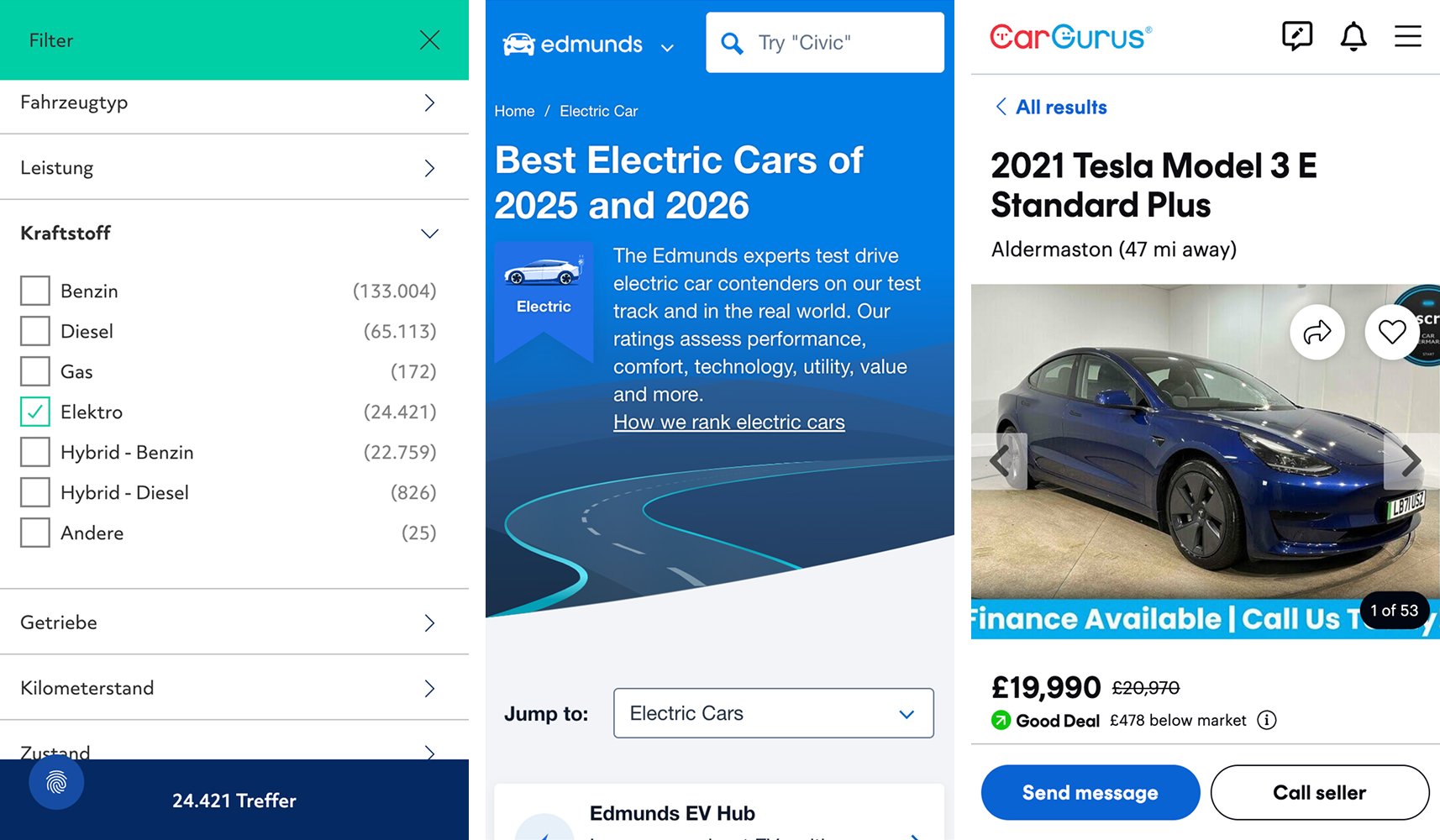
Local and international competitor testing formed. Web and apps
Key research takeaways
EV buyers struggle to find relevant listings – Existing filters and data were insufficient
Uncertainty leads to hesitation – Many potential buyers were stuck due to range anxiety, unclear charging information, and government incentives
Competitors provided better tools – Our research revealed that UK and US platforms offered richer data, making EV searching easier
Expert and stakeholder interviews
In addition to the user interviews, we also spoke with EV experts who had been working in the industry for some time.
People working in the industry and long-term EV owners. They explained what they needed as a first time EV buyer, the issues the industry need to overcome for EVs to be heavily adopted, and their own suggestions for how mobile.de can help.
Insights and opportunity areas
With a good amount of data collected and insights gleaned through the four discovery activities, we had a solid foundation to ideate, design and build from.
With a broad range of opportunity areas, we needed to focus on the most impactful problems first.
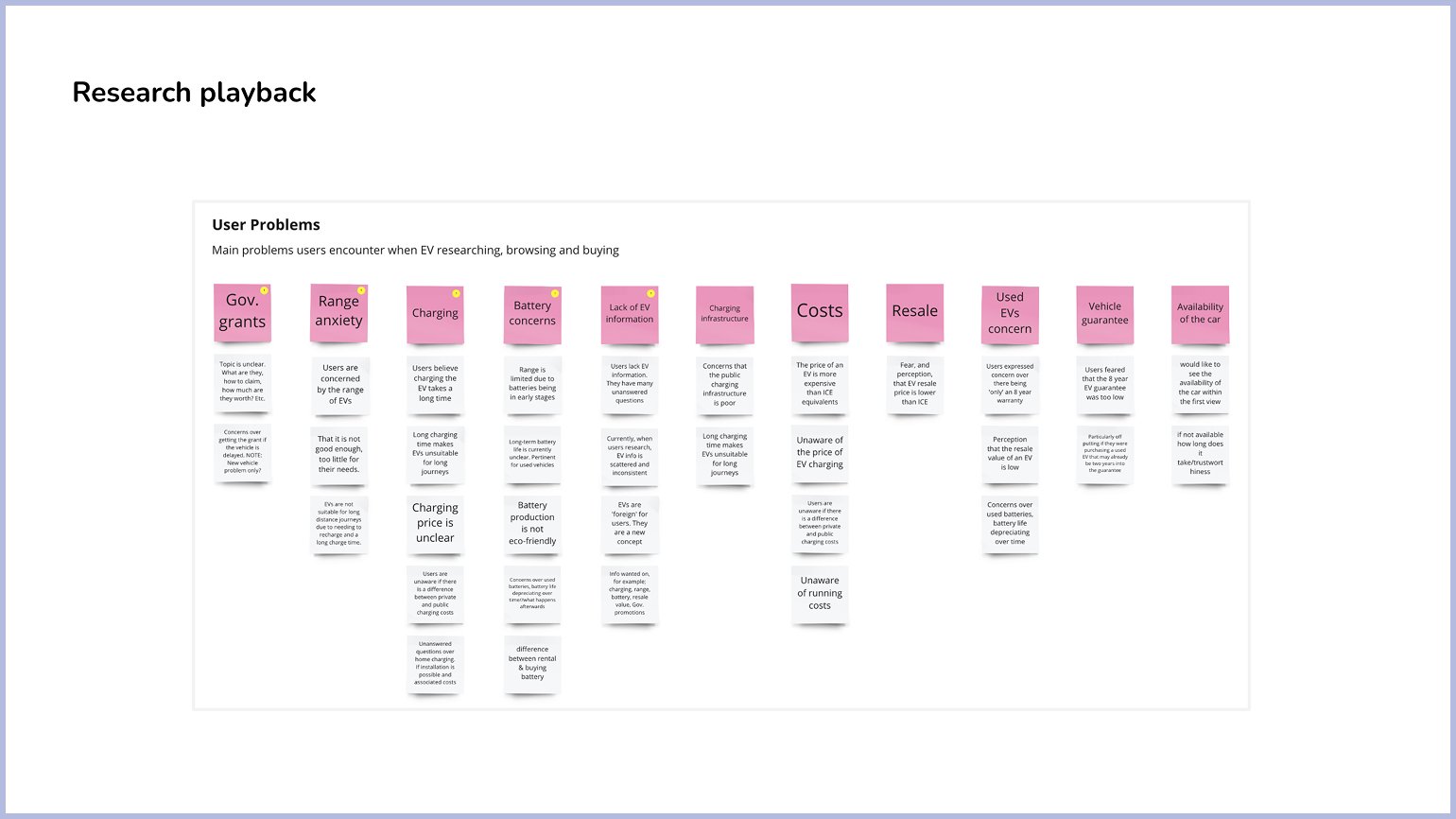
Broad range of user problems
Using the RICE framework, stakeholder input, and product intuition, we honed in on the biggest blockers for adoption:
Government grants
Range anxiety
Charging
These three areas were consistently cited in user research as key decision-making barriers and ranked highly in quantitative studies.
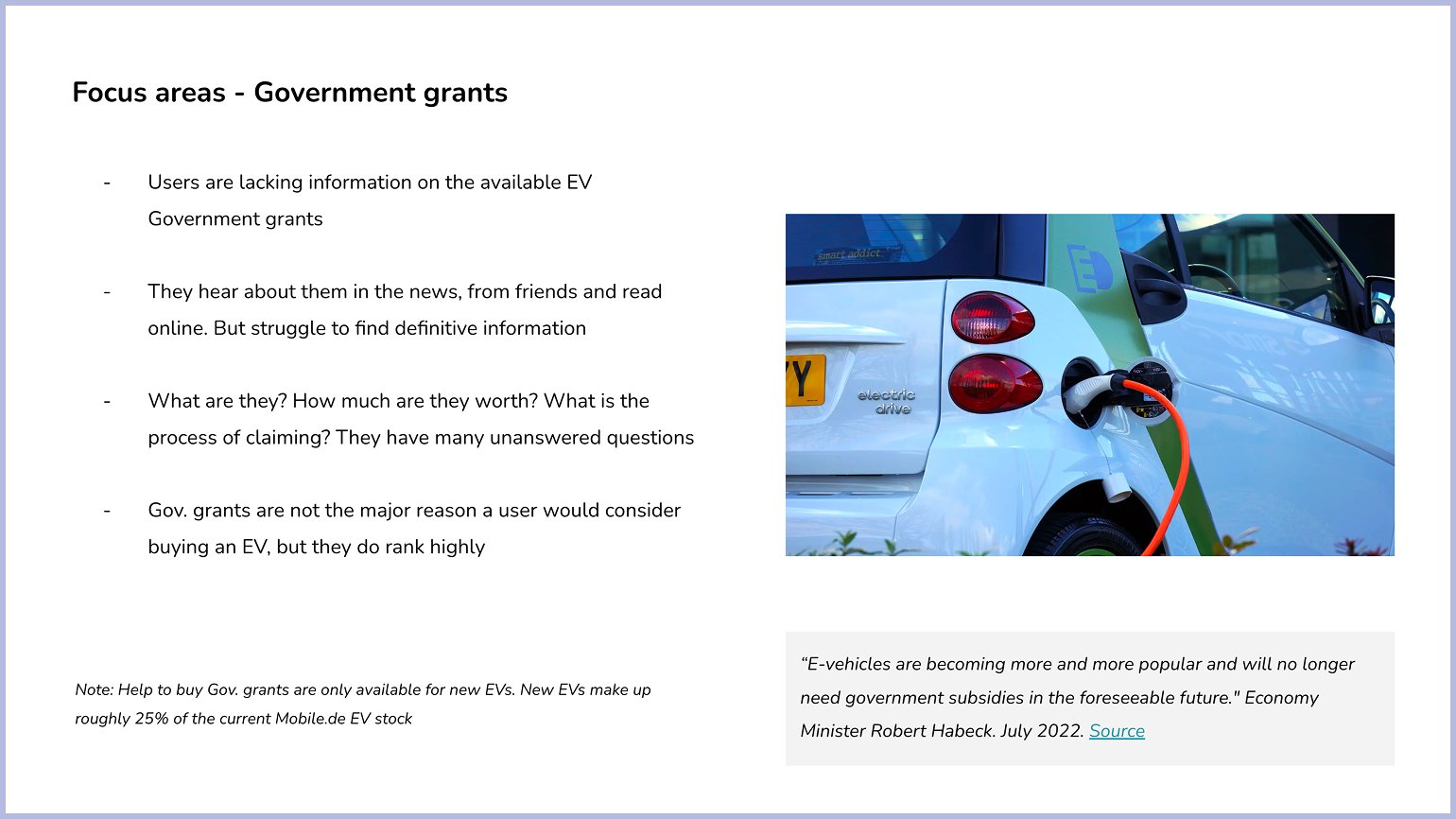
Focus Area 1 - Government grants

Focus Area 2 - Range Anxiety
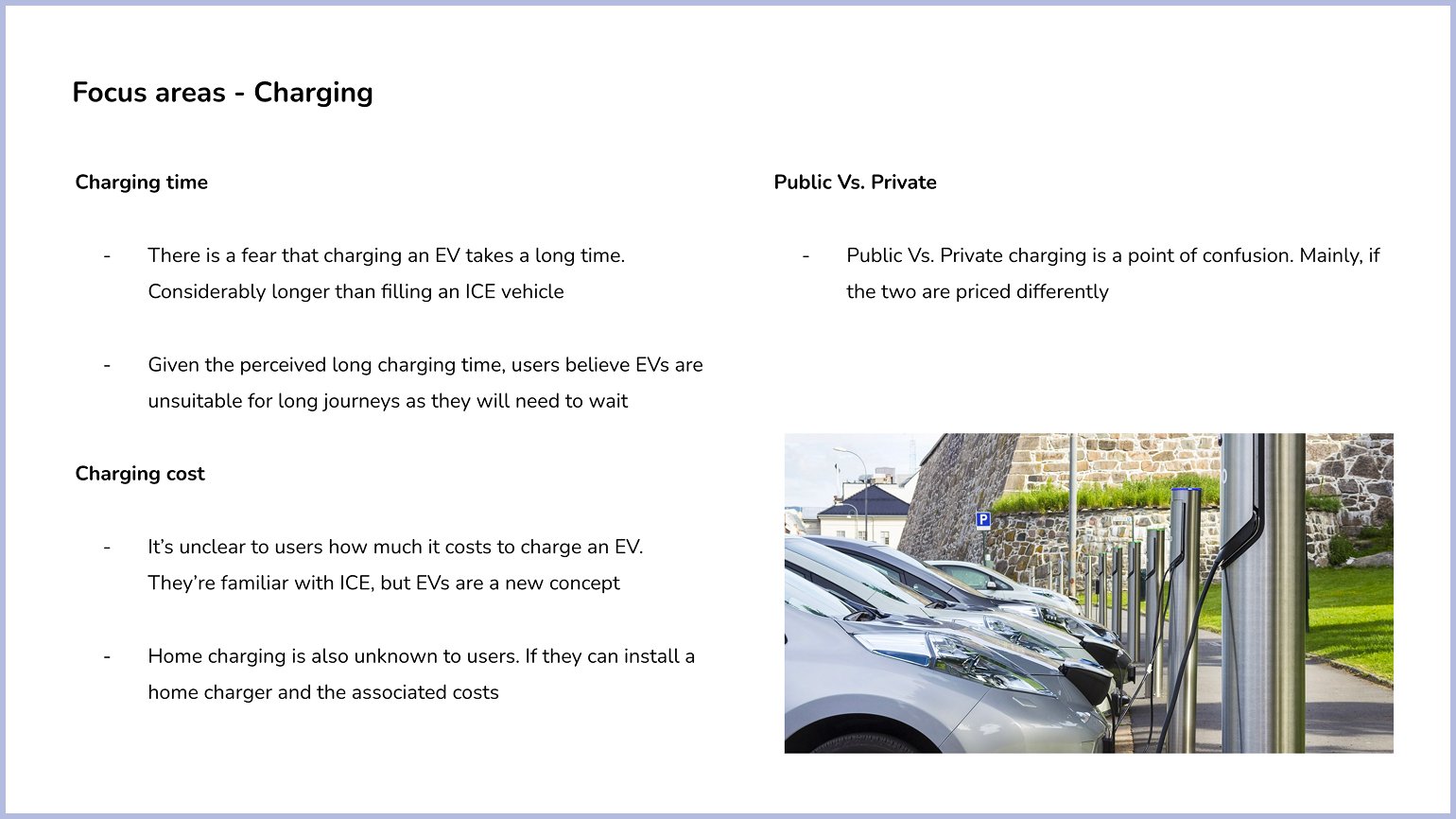
Focus Area 3 - Charging
Ideation workshops
To kick-start the ideation and gather many ideas quickly, I facilitated ideation workshops with the team and employees interested in EVs.
I ran the workshops using a simple format of:
User research playback
Key insights
Opportunity areas
How might we questions
Ideate
The output was paper sketches, screenshots and digital post-its that I took away to build upon.
Moving quickly from wireframes to high-fidelity mock-ups. Doing so in collaboration with the team as we became confident the ideas were desirable, feasible and viable.
But of course we needed to put these ideas in front of buyers to test them.
Concept cards and testing
An approach I utilised was concept cards. A single slide containing the name of the idea and a product mock-up.
This approach is lean. I could produce a concept card quickly and throw it away if it tested poorly. Or iterate upon the idea following user feedback.

Charging information concept card
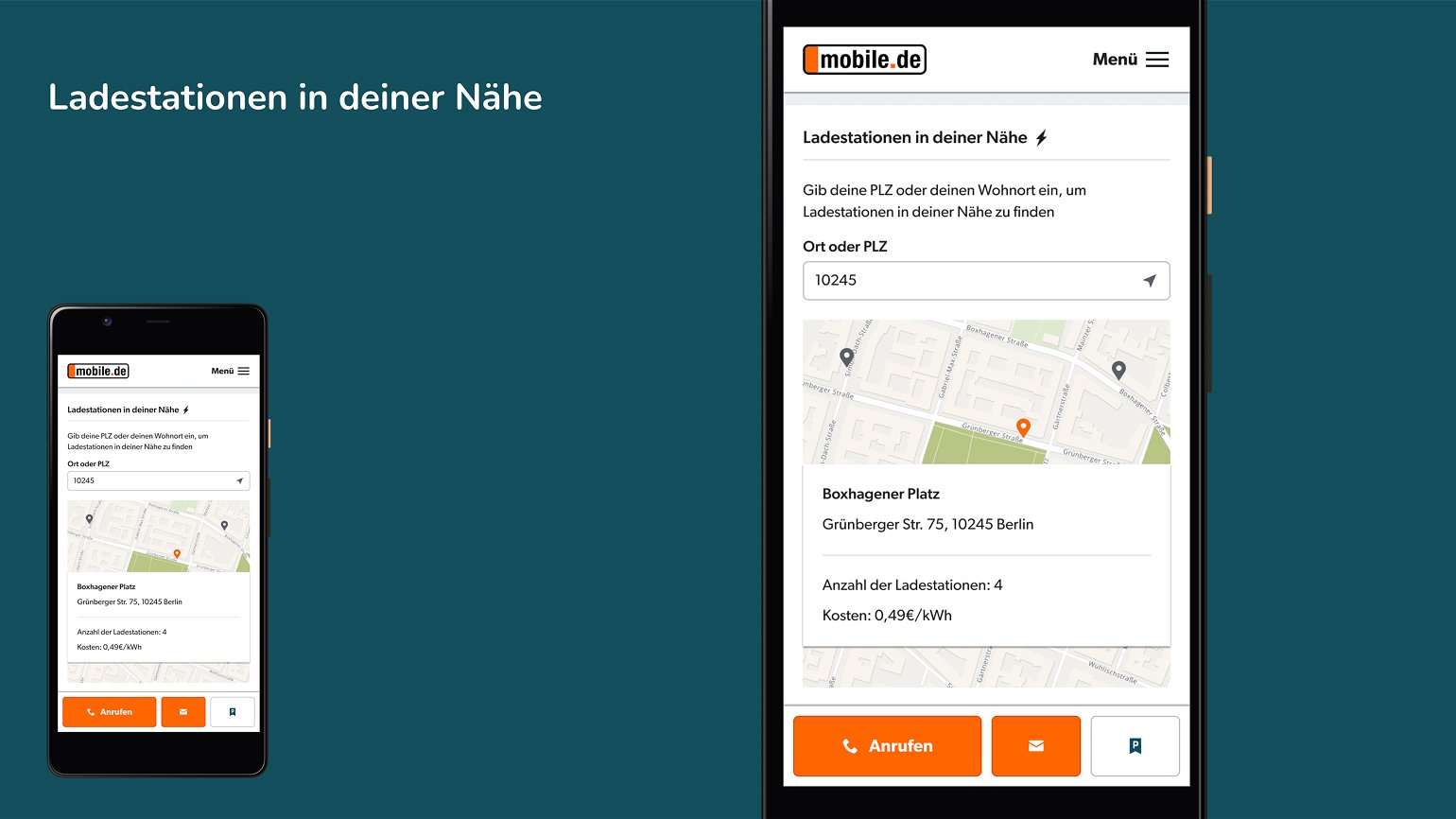
Charging map and information concept card

EV vs. Petrol/Diesel comparison concept card

EV information concept card
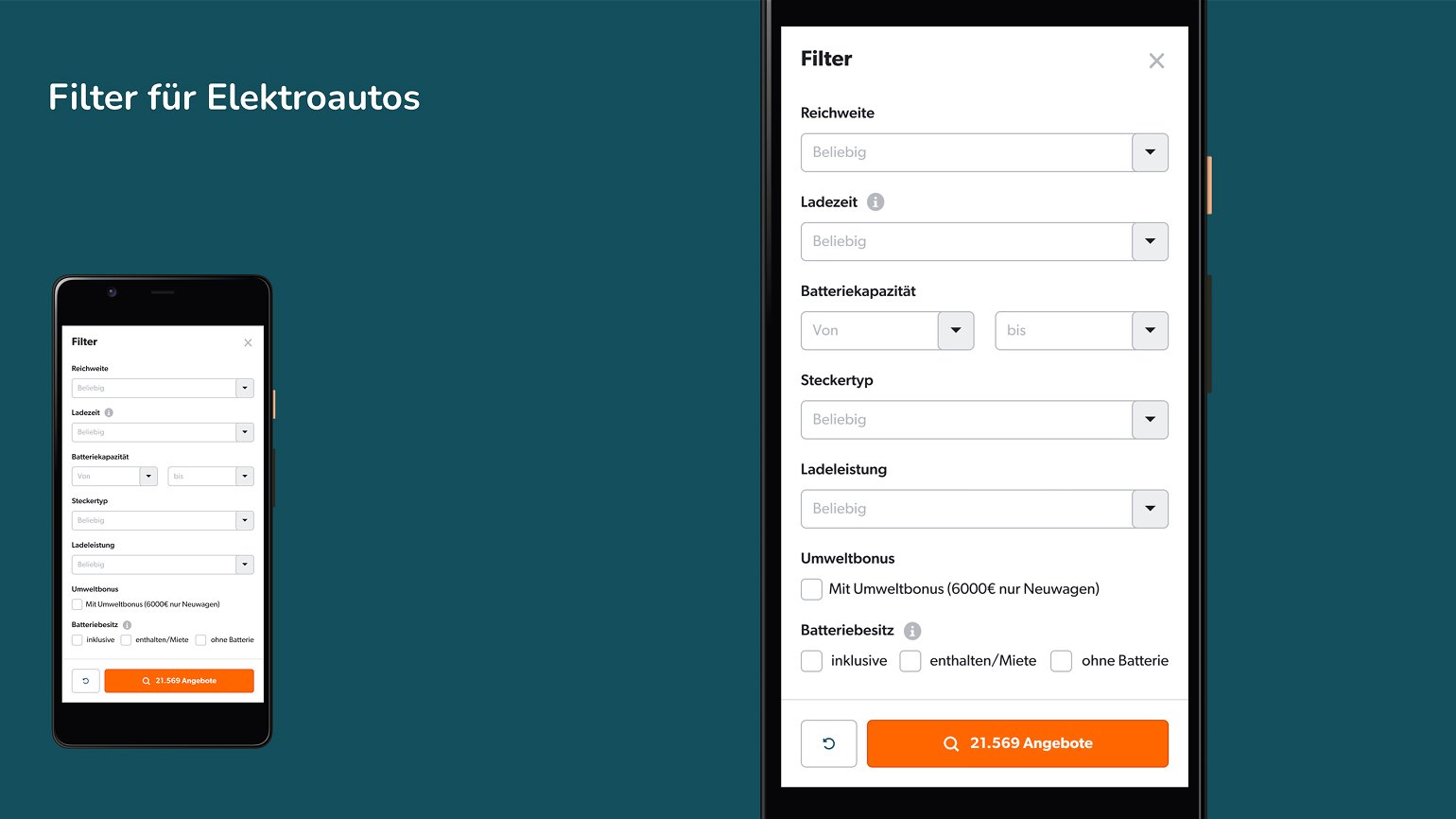
EV Filters concept card
Through multiple user feedback sessions we showed the ideas to buyers. Removing and improving the ideas over the course of a week.
Prototype testing
With feedback gathered, we reduced our large amount of ideas to the best performing ones with the perceived highest impact. From there I built these ideas out into fully functioning prototypes that covered key user journeys.
These too were tested with active car buyers, a mix of those wanting an EV and those considering an EV as their next car. From there I got into the cycle of testing, iterating and testing again.
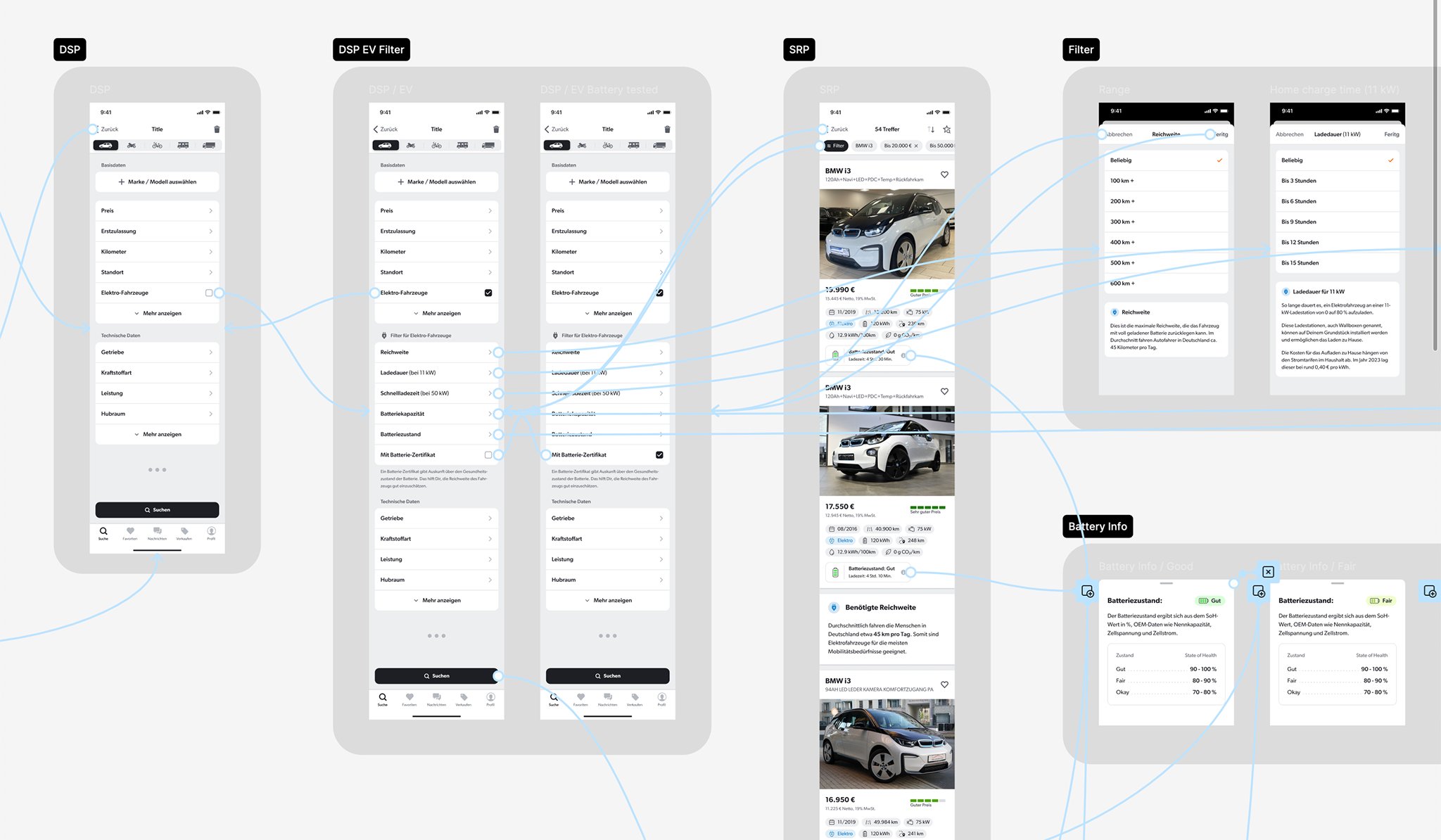
Prototype created for user testing
Launching, A/B testing and iterating
With prototypes tested and iterated upon, we had a solid backlog of ideas that were ready to be put live. Smaller ideas were shipped immediately, to get the value to users asap.
For the bigger ideas which affected key parts of the user journey, we A/B tested. We soon got into the flow of a well functioning product team. Shipping, testing and iterating upon the functionality we were launching.
The mobile.de EV experience
Home
An EV presence. Given mobile.de’s strong market position, Home is the starting point for the majority of user journeys. Previously, there was no mention of EVs.
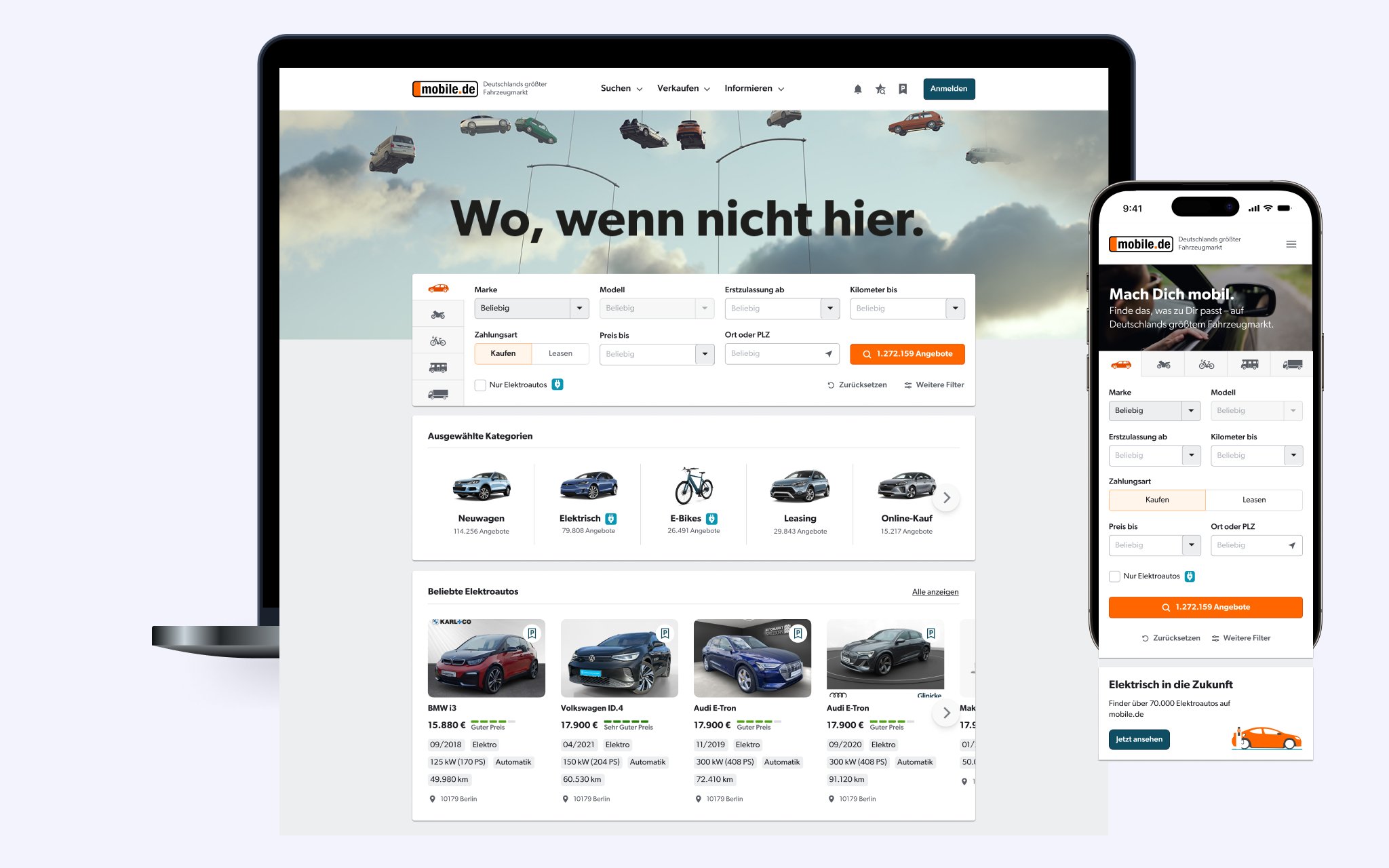
Strong EV presence on Home. Journey starting point for many across web and apps
Filters
User’s can now easily find EVs that meet their mobility needs. Filters for range, charge time, fast charge time and used EVs that have had their battery tested.
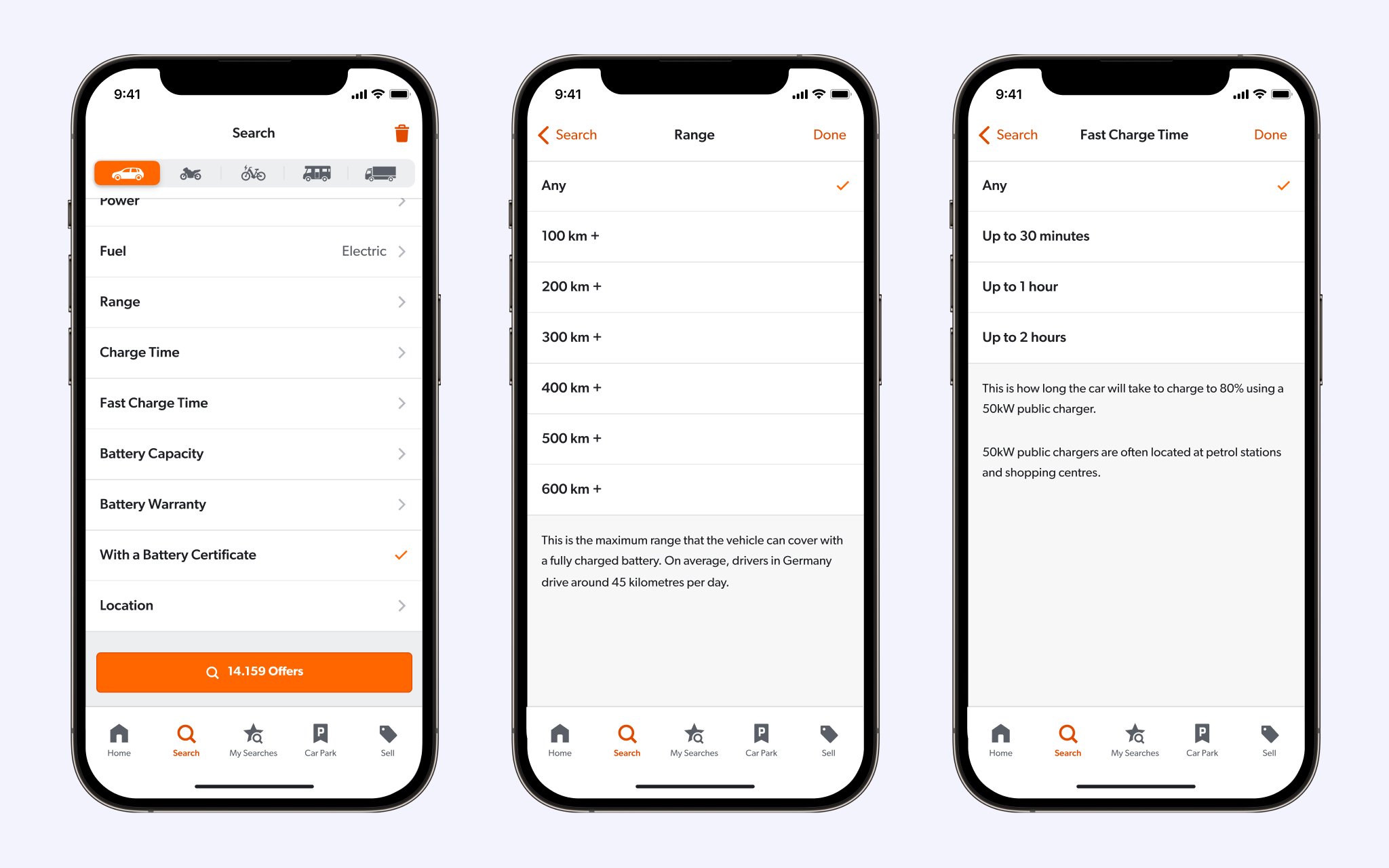
Detailed filters ensure users can find EVs that meet their mobility needs. iOS
Listings
EV listings now show vehicle data buyers need, such as range and charge time. As well as information about public and private charging.

EV listings show key vehicle data and inform the user about charging
Battery Certificate
User’s are concerned by the quality of batteries in used EVs. To solve this problem, used EVs are tested by independent companies and issued a report. We enabled Dealers to mark their vehicles as tested and upload the report to be viewed by buyers.

Find used EVs that have had their batteries tested and a report issued
Government Grants (Umweltbonus)
To encourage EV adoption the government issued grants to people that bought new EVs. We gave Dealers the ability to mark their vehicles that qualified. For buyers, they could filter for these vehicles, learn more about the bonus and identify which vehicles qualified.
The Umweltbonus was stopped in December 2023, subsequently this functionality was removed.

Learn about EV Government Grants and find qualifying vehicles
Impact
The redesigned EV experience transformed mobile.de into the go-to platform for EV buyers in Germany.
Key product metrics skyrocketed:
+38% increase in EV searches
+21% more EVs viewed
+14% increase in messages to dealers (Key business metric)
+6% increase in EV lead ratio
Strengthening mobile.de’s position as the leading automotive marketplace in Germany. Whilst simultaneously laying the foundations for further improvements as EVs grow.